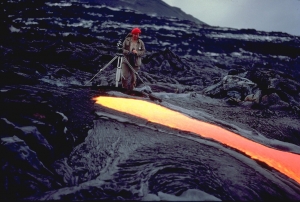Since the beginning of human civilization, we have been fascinated by the terrifying beauty of the volcano. With their impressive yet volatile nature, most people are content with viewing them from afar. Instead, they rely on archival footage of eruptions, lava flows or ash plumes that can be appreciated from the comfort of their own homes. But who are the ones capturing these images?

Image of a Volanic landscape with an orange lava flow
On the 3rd June 1991, Mount Unzen erupted in Japan, taking the lives of 37 people, including Katia and Maurice Krafft. They had died pursuing their one true love: volcanoes.
Because of the dedicated work of Maurice, Katia and their peers, there is more education about the hazards of volcanic activity, and responses to protect the local communities are much swifter and more effective. The Centre for the Study of Active Volcanoes in Hilo, Hawaii, have established a memorial fund in the Krafft’s name which collects donations that continue their mission of education. Their contributions to the field of volcanology are still evident to this day.
The precious images created by Maurice and Katia Krafft also remain.
This very footage has been repurposed by director Sara Dosa in the award-winning 2022 documentary Fire of Love. Combined with skilful editing, captivating narration and an awe-inspiring soundtrack, the hundreds of hours of gorgeous geological film by the Kraffts have been compiled into an accessible feature-length. The film honours their legacy, recalling their story of volcanic passion to a new generation of audiences, ensuring that Maurice, Katia and the work they created- will never be forgotten.